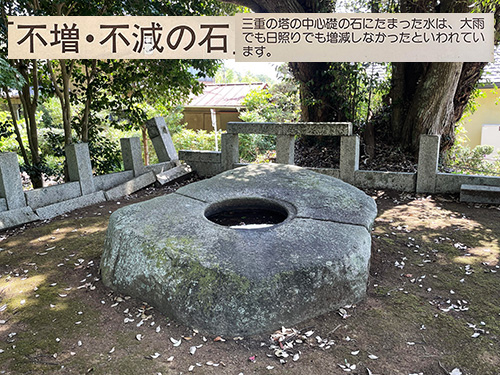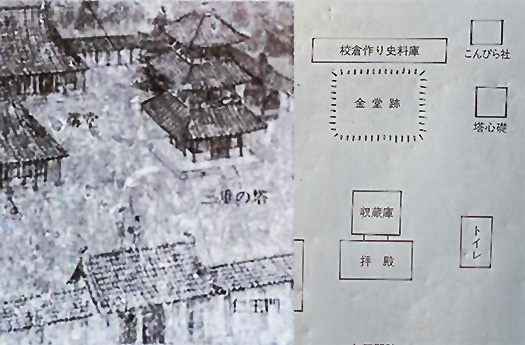


龍角寺本堂(現本堂跡)の東約13間(約23.4m)にこの不思議の石、不増不減の石はある。これは龍角寺縁起が伝える三重とも七重とも言われる「塔」の心礎石とされている。なお「不増不減」は般若心経の一節で仏教思想の根幹にかかわるキーワード。ネーミングからも仏教教化の思惑が偲ばれる。
この心礎は長径249cm、短径203cmの花崗岩の表面を削って平らにして、中央に直径81.8cm、内径66.6cm、深さ12.1cmの円孔を穿っている。その両端には水気抜きの小溝を刻んでいる。この心礎石の大きさから推定して、塔の高さは33mほどと推定されている。法隆寺・五重塔では基壇からの高さ31.5mとされているので、ほぼ同程度の塔だったことになる。
また、この穿った柱穴は雨が降っても日照りになっても中に蓄えられた水は増えもせず、減少することもないとされて、龍角寺の七不思議のひとつに数えられているとのこと。この七不思議という説話も面白いのだけれど、あまりにも日本昔話的横道なので自制(笑)。興味ある方はリンク先・千葉県栄町HPでお楽しみください。
その七不思議はどうも水とか、沼とかのこの地域特有の説話だと感じさせる。いやそもそも、龍角寺自体、和銅2年(709年)に竜女化来し一夜のうちに諸堂(金堂、塔)を建立したと伝えられて、さらに寺宝として命名に関わる「竜伝説」の小龍の頭部のミイラが保有されていることでも有名。
〜天平3年(731年)の夏はことのほか暑く水不足となり、時の聖武天皇の命により、龍角寺の釈命上人が雨乞いの祈祷を行うと、印旛沼の主の小竜が大竜に殺されることを承知でその願いを聞き入れ、七日七晩雨を降らせてくれた。雨が上がった後、沼のほとり3ヶ所で分断された竜の死体が見つかり、上人は竜との約束どおり頭を龍閣寺に葬り寺の名を龍角寺と改めました。〜
オイオイ、でありますがそういった伝説の霞に深く包まれている。
この不増不減の石は国指定史跡の重要な構成要素であり、本尊の銅造薬師如来座像は国指定重要文化財としても登録されている。戦前期には国宝にも指定されていたのだ。
北海道人としては、本州地域での地域史の深遠さを深く思い知らされる気分。史実としては蘇我氏由来の国家的なプロジェクトとしてこの地に龍角寺は創建されたことは間違いないけれど、鄙の人びとに宗教性の「ありがたさ」を伝えていくときに、龍だとか、奇跡・不思議譚などのオブラートでくるんで伝えた方がわかりやすかったのではないかとも推測できる。
この龍角寺の創建譚のなかに、はじめて仏教という思想に触れた人びとへのそのような「教化」の思惑が隠されていると思えてくる。
おっと、こちらもついつい想像力の魅力的なワナに落っこちそうであります(笑)。
English version⬇
The foundation stone of the central pillar of the pagoda, “Non-increasing and Non-decreasing Stone”, Ryukaku-ji Temple 4: Exploration of Three Shrines in Eastern Japan – 11
The foundation stone of the pagoda’s central pillar, the “nonincreasing and non-reducing stone,” is the foundation stone of the pagoda’s central pillar, the “nonincreasing and non-reducing stone. …
This mysterious stone is located approximately 13 ken (23.4 m) east of the main hall of Ryukakuji Temple (the current site of the main hall). It is believed to be the cornerstone of a three- or seven-story “pagoda,” according to the legend of Ryukakuji Temple. The phrase “nonincrease/non-decrease” is a key word in the Heart Sutra, which is the foundation of Buddhist thought. The naming of the pagoda also suggests a desire for Buddhist indoctrination.
The cornerstone is made of granite with a long diameter of 249 cm and a short diameter of 203 cm, with a flattened surface and a circular hole in the center with a diameter of 81.8 cm, an inside diameter of 66.6 cm, and a depth of 12.1 cm. Small grooves for drainage were carved at both ends. Based on the size of this central foundation stone, the tower is estimated to be about 33 meters high. The five-story pagoda at Horyu-ji Temple is estimated to have been 31.5 m high from the base, which means that the pagoda was about the same height.
It is also said that the water stored in this hole neither increases nor decreases even in rain or shine, and is considered one of the Seven Wonders of Ryukakuji Temple. This is one of the Seven Wonders of Ryukakuji Temple. The story of the Seven Wonders is interesting, but it is too much like a Japanese folktale, so I restrain myself (laugh). If you are interested, please visit the website of Sakae Town, Chiba Prefecture.
The Seven Wonders of Sakae are apparently unique to this area, with its water, swamps, and such. To begin with, Ryukakuji Temple itself is said to have been visited by a dragoness in 709 and built various halls (Kondo and Pagoda) in a single night, and is also famous for holding a mummy head of a small dragon, which is related to the “dragon legend” of its naming, as a temple treasure.
〜In the summer of 731 (Tempyo 3), it was extremely hot and there was a shortage of water. After the rain had stopped, the corpse of the dragon was found split up in three places along the banks of the swamp. As promised to the dragon, the shonin buried the head in Ryukaku-ji Temple and renamed the temple Ryukaku-ji Temple. The head of the dragon was buried at Ryukaku-ji Temple and the temple was renamed Ryukaku-ji Temple. ~.
It is deeply shrouded in a haze of legends.
This stone of non-increase and non-reduction is an important component of the nationally designated historic site, and the main statue of Yakushi Nyorai, a bronze statue of Yakushi Nyorai, is also registered as a national important cultural property. It was also designated as a national treasure in the prewar period.
As a Hokkaido native, I am deeply reminded of the profundity of local history in the Honshu region. Although the historical fact is that Ryukakuji Temple was built here as a national project of the Soga clan, it may have been easier to convey the “gratitude” of religiosity to the local people by wrapping it in the language of dragons, miracles, and mysterious stories.
In this tale of the founding of Ryukaku-ji Temple, it seems that this kind of “indoctrination” of people who first came into contact with the idea of Buddhism is hidden.
I am about to fall into the fascinating trap of imagination (laugh).
Posted on 8月 15th, 2023 by 三木 奎吾
Filed under: 日本社会・文化研究







コメントを投稿
「※誹謗中傷や、悪意のある書き込み、営利目的などのコメントを防ぐために、投稿された全てのコメントは一時的に保留されますのでご了承ください。」
You must be logged in to post a comment.